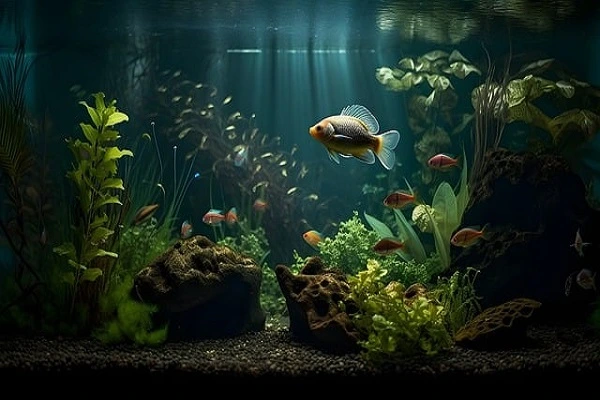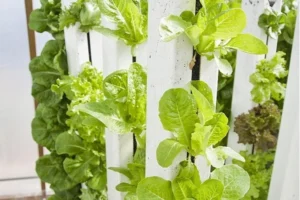Having a thriving, self-sustaining garden that produces fresh herbs, vegetables, and even fish, all while taking up minimal space sounds good, right? That’s the beauty of combining aquaponics with vertical gardening.
Aquaponics is a closed-loop system that integrates aquaculture (raising fish) with hydroponics (growing plants without soil). The fish produce waste, which is broken down by beneficial bacteria into nutrients that plants need to grow. In return, the plants help filter and clean the water, creating a balanced, natural ecosystem. This method not only conserves water but also eliminates the need for chemical fertilizers, making it an eco-friendly and efficient way to cultivate food.
Now, pair aquaponics with a vertical garden, and you have a space-saving powerhouse. Vertical gardening allows plants to grow upward rather than spreading out, making it ideal for urban settings, balconies, or small backyards. By stacking plants in tiers, you maximize productivity without requiring much ground space. Plus, this setup enables continuous harvesting regardless of the time of year, as you can control environmental factors to keep your plants thriving across different growing cycles.
By merging these two techniques, you get the best of both worlds—a low-maintenance, high-yield system that produces fresh food in any climate. Whether you’re a beginner or an experienced gardener, an aquaponic vertical garden is an innovative way to cultivate plants efficiently while making the most of limited space.
Understanding Aquaponics
Aquaponics is a smart, sustainable way to grow plants and raise fish in a single, self-sustaining system. At its core, it’s all about balance—fish provide nutrients for the plants, and in return, the plants help purify the water for the fish. This natural cycle mimics the way ecosystems work in the wild, creating a thriving environment where both plants and aquatic life support each other.
To make this system function, a few essential components are needed. First, there’s the fish tank, where your aquatic life lives and produces waste. That waste is then broken down by a biofilter, converting it into nutrients that plants can absorb. The grow bed houses the plants, allowing their roots to soak up these nutrients. A water pump keeps everything circulating, ensuring that both the fish and plants receive what they need to flourish.
One of the biggest advantages of aquaponics is its efficiency. Since the water continuously recirculates, this method uses far less than traditional gardening, making it an eco-friendly choice. It also removes the need for chemical fertilizers, since the fish naturally provide nourishment for the plants. Plus, an aquaponic system can be adapted to grow fresh produce no matter the time of year, whether it’s the peak of summer or the depths of winter. With the right setup, you can enjoy homegrown greens, herbs, and even fruiting plants across multiple growing periods, regardless of the outdoor climate.
By harnessing this natural synergy, aquaponics offers a sustainable, low-maintenance way to grow food efficiently while reducing waste and conserving resources.
Why Choose a Vertical Garden for Aquaponics?
If you’re short on space but still want a productive and efficient garden, vertical gardening is the perfect solution—especially when combined with aquaponics. Instead of spreading plants across a wide area, this approach allows them to grow upward, making the most of limited space while still providing a lush and thriving garden.
One of the biggest advantages of a vertical aquaponic setup is how much you can grow in a compact area. By stacking plants in layers, you maximize every square foot, producing a higher yield than a traditional horizontal layout. This is especially beneficial in urban environments where space is limited, whether you have a small backyard, a balcony, or even just a sunny wall.
Beyond practicality, a vertical aquaponic garden also adds a unique visual appeal. The sight of cascading greenery, thriving vegetables, and flowing water creates a stunning, living centerpiece that enhances any space. But it’s not just about looks—this setup also provides better airflow around plants, reducing disease risk and promoting healthier growth.
Another major benefit is the ability to cultivate fresh produce across different growing cycles, regardless of the weather outside. Whether it’s the height of summer or the middle of winter, you can maintain a steady supply of herbs, leafy greens, and even fruiting plants by adjusting environmental conditions. This means fresh, homegrown food is always within reach.
By choosing a vertical approach, you get a practical, visually appealing, and highly efficient way to combine aquaponics with gardening—proving that limited space doesn’t have to limit your harvest.
Setting Up an Aquaponic Vertical Garden
Creating an aquaponic vertical garden might sound complex, but with the right setup, it can be a straightforward and rewarding project. By selecting the ideal location, choosing the right combination of fish and plants, and gathering the necessary equipment, you’ll be on your way to a thriving system that provides fresh food year-round.
Choosing the Right Location and Structure
Location is key to a successful vertical aquaponic garden. Look for a spot that gets plenty of natural light, such as a sunny wall, balcony, or greenhouse. If growing indoors, consider supplemental grow lights to keep your plants healthy. Stability is also important—since your system will hold both plants and water, it should be securely anchored to prevent tipping or strain on the structure.
Selecting Fish and Plants
The best aquaponic gardens use fish and plants that work well together. Hardy fish like tilapia, goldfish, or koi are popular choices because they adapt well to various conditions. If you’re in a cooler climate, trout might be a better option. For plants, leafy greens such as lettuce, spinach, and basil thrive in aquaponic systems, while fruiting plants like tomatoes and peppers can also do well with proper care.
Essential Equipment and Materials
To get started, you’ll need:
- A fish tank to house your aquatic life
- A grow bed or vertical tower to hold your plants
- A water pump to circulate nutrients
- A biofilter to convert fish waste into plant-friendly nutrients
- Grow media like clay pebbles or gravel to support plant roots
- Tubing and plumbing to connect everything smoothly
Step-by-Step Setup Guide
- Set up the fish tank – Place it in a stable, well-lit location.
- Install the grow bed or vertical towers – Ensure they are securely positioned above the tank.
- Connect the water pump and filtration system – This will keep the water cycling between the fish and plants.
- Add grow media – Use lightweight materials like expanded clay pellets to support plant roots.
- Cycle the system – Before adding fish, allow beneficial bacteria to establish by running the system for a few weeks.
- Introduce fish and plants – Start with hardy fish and easy-to-grow plants to ensure a smooth transition.
- Monitor and adjust – Regularly check water quality, fish health, and plant growth to keep everything balanced.
With this setup, you can enjoy a continuous harvest of fresh produce. Whether you’re dealing with scorching summers or chilly winters, your aquaponic vertical garden will provide homegrown food across different growing periods, making it a sustainable and rewarding way to garden in any environment.
Maintaining Your Aquaponic Vertical Garden
Once your aquaponic vertical garden is up and running, keeping it in top shape requires regular care. The good news is that this system is largely self-sustaining, but a little attention goes a long way in ensuring both your fish and plants stay healthy. By monitoring water quality, feeding your fish properly, and preventing common problems, you’ll enjoy a productive garden all year.
Keeping an Eye on Water Quality
Since water serves as the lifeline of your system, maintaining proper balance is crucial. Three key factors to check regularly are pH, ammonia, and nitrates. A pH level between 6.8 and 7.2 keeps both fish and plants happy. Too much ammonia—produced from fish waste—can be toxic, while nitrates, which plants use for growth, should be kept at a steady level. Using a simple water testing kit weekly helps you catch any imbalances early before they become a bigger issue.
Feeding Fish and Maintaining a Balanced Ecosystem
Your fish play an essential role in the success of your aquaponic garden, so their care is just as important as tending to your plants. Feeding them a high-quality diet in small amounts ensures they stay healthy without producing excess waste. Overfeeding can lead to water contamination, so it’s best to offer food in portions they can finish in a few minutes. Also, choosing the right fish-to-plant ratio keeps the system balanced—too many fish can lead to poor water quality, while too few may not provide enough nutrients for the plants.
Preventing Common Issues
To keep your system running smoothly across different growing cycles, be proactive in preventing problems like algae buildup, clogged filters, and fish diseases. Algae thrive in direct sunlight and can quickly take over a system, so keeping your fish tank shaded helps prevent unwanted growth. Regularly checking and cleaning filters ensures water flows freely, keeping oxygen levels stable for your fish. Lastly, watch for signs of illness, such as unusual swimming behavior or loss of appetite, and take action quickly if needed.
With the right maintenance routine, your aquaponic vertical garden will continue to provide fresh, homegrown produce regardless of the time of year. By staying on top of water quality, fish care, and system upkeep, you’ll enjoy a thriving, low-maintenance garden that flourishes through every growing period.
Final Thoughts
Aquaponic vertical gardening is a game-changer for anyone looking to grow fresh, organic food in a sustainable way. By combining aquaponics with vertical gardening, you create a system that conserves water, maximizes space, and provides a continuous harvest across different growing periods. Whether you have a small balcony or a backyard, this approach makes it possible to cultivate plants efficiently without the need for large garden beds or excessive maintenance.
If you’re new to this method, don’t feel overwhelmed—starting small is the best way to learn. Begin with a simple setup, choose easy-to-grow plants like lettuce or herbs, and select hardy fish such as tilapia or goldfish. As you gain confidence, you can expand your system, experiment with different plant varieties, and fine-tune your water quality for even better results.
By embracing aquaponic vertical gardening, you’re not just growing food—you’re creating a self-sustaining ecosystem that supports both plants and aquatic life. With a little patience and experimentation, you’ll enjoy fresh produce and a thriving garden across every part of the year.




